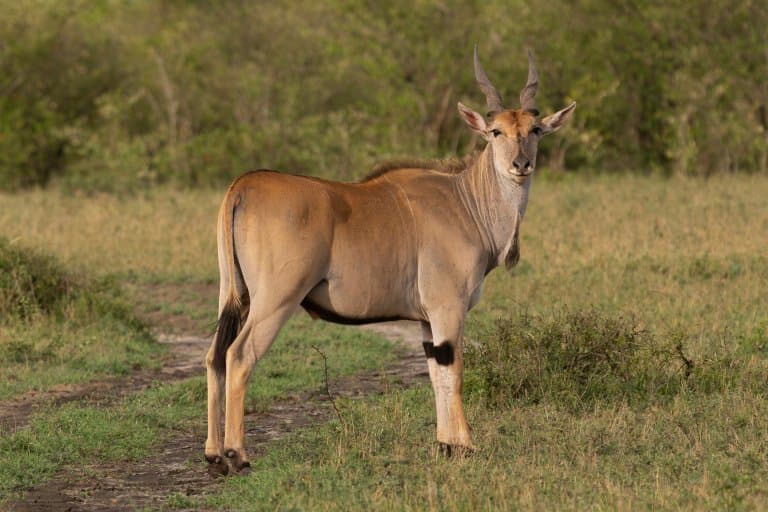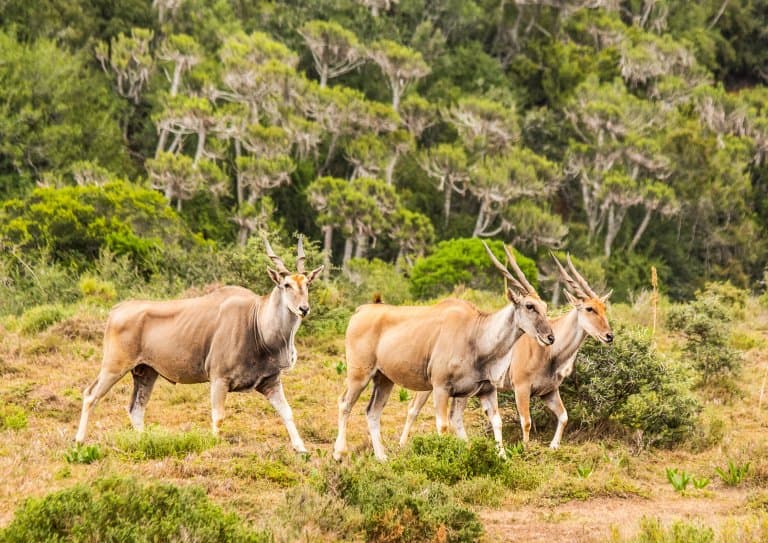Common Eland Profile
If the moose/elk confusion wasn’t tedious enough, Europeans have gone and spread their ungulate misidentification to yet another continent, naming one of Africa’s largest antelope after the European moose.
The common Eland is the second-largest antelope in Africa, and quite clearly not a moose. They are also known as the southern eland, or eland antelope, and are found in savannah, plains and grasslands in East and Southern Africa.

Common Eland Facts Overview
| Habitat: | Forest, savanna, shrubland, grassland |
| Location: | Southern and Eastern Africa |
| Lifespan: | Around 20 years |
| Size: | 1.6 m (5.2 ft) tall |
| Weight: | Up to 1,000 kg (2,200 lb) |
| Colour: | Grey, brown, sometimes with vertical stripes |
| Diet: | Mostly grasses and leaves, flowering plants |
| Predators: | Cheetahs, lions, hyenas, African wild dogs, humans |
| Top Speed: | 40 km/h 25mph |
| No. of Species: | 1 |
| Conservation Status: | Least Concern (IUCN) |
Common elands are spiral-horned antelopes. Both males and females have horns, and they are the second-largest antelope in the world, after their sibling group the Greater Elands. They are impressive, powerful animals with remarkable dry-weather adaptations.
They are herbivores and will spend their time eating grasses in rainy season and browsing leaves during the winter – in herds of up to 500 individuals. In Southern Africa, they will often herd alongside zebras, oryx and other antelopes.
These enormous antelopes have a long history in human culture and are still providing novel ways for people to make soup to this day.
Thankfully, they’re doing pretty well as a species, in no small part due to their spiky front ends.
Interesting Common Eland Facts
1. Oh deer
In the Netherlands, a moose is called an Eland, or elk. This name was commonly used in Europe to mean “big deer”, which led to it being used to name the wapiti in North America before the real moose (or elk) showed up and confused everything.
In 1977, Dutch settlers brought this naming tradition to Africa, slapping it onto what was presumably the first big animal they saw, despite it being a bovid, not a deer. To make matters worse, this animal’s scientific name is T. oryx, which might be confused with the genus Oryx, containing some very different antelope species.
There are now two “elanden” species in Africa, the Common Eland being second in size only to the Great Eland, the largest antelope on the continent.
There are three subspecies, the Cape eland being one that’s commonly referred to as alces: the Latin name for moose.
There’s no solution to this chaos, you just have to deal with it.

2. They’re huge!
Thankfully, if you can remember there are barely any deer species in Africa, you may only need to go by their size to get it right. Elands are the biggest antelope in Africa, and while the common eland is shorter than its Greater cousin, you still wouldn’t be able to throw one very far.
A decent-sized common eland will stand up to 1.8 meters tall and could weigh over 900kg, though they average around 600kg.
While male and female common elands have a big saggy neck bag called a dewlap, those found in males can grow to exaggerated proportions, dangling as low as the ankles, and both sexes have spiralled horns.
All this extra weight makes them a slow animal and considered perhaps the slowest antelope, at around 40 km/h. But what they lack in speed, they make up for in athleticism, being able to jump almost three meters straight up from a standing start! 1
3. They’re cool
While a large size is very useful at retaining heat, this huge mass can be difficult to work with in hot climates. Elands have specific adaptations to regulate their body temperatures using fine control over their sweat.
These animals can control how much water they release and can supplement the cooling effect with panting, when necessary. It’s also thought that the dewlap is used as a radiator, able to contribute to thermoregulatory processes by warming or cooling the blood.
This dewlap is also a product of maturity, which allows the rest of the herd to identify the more experienced animals. 2
4. They communicate with their knees
It’s said you can always hear a herd of eland coming. For mysterious reasons, their front knees click as they walk, and the sound of multiple individuals can be heard from several hundred meters away.
Nobody has figured out exactly why this is, but it might have something to do with keeping the herd together. Alternatively, it’s been shown that the quality of the sound can indicate the size of the animal, which suggests that males can size one another up without resorting to expensive battles. 3
5. Common elands will also vocalize
Elands can bark when they spot a predator, which warns the rest of a herd. As well as vocalizations and knee clicking, they also have various display behaviours including trotting forwards and backwards, as well as scent cues.
Eland have many predators, including lions, cheetahs, spotted hyenas and African wild dogs.
6. They’re of huge historical significance to human populations
The common eland has supplied local peoples with meat, leather and milk for thousands of years. The milk of the eland is high in fat, in some instances containing 12%, making it highly nutritious and providing advantages over domestic cattle.
They’re also tough and can go a long time without access to water, making them ideal candidates for domestic livestock in arid regions. 4
7. They’re potentially domesticable
Domestication is on the cards, too, and these antelope are well known for taming quickly and being generally amicable.
While they’re gentle and calm, they do need vast areas to graze, and access to nutrient licks, which increases the potential cost of domesticating. They also eat a lot. In areas where it’s exceptionally hot, the eland may choose to graze at night, which then makes them vulnerable to large predators, further increasing the cost of their husbandry to include protection against these.
Their mass and athleticism also make them hard to fence in, or indeed out, as wild populations have been known to break into livestock paddocks with ease.
But a captive eland can provide up to 6.8kg of very rich milk per day, and this preserves for far longer than domestic cow milk; one study showed that eland milk can be stored at 37°C for up to eight months without going bad!
8. Eland goulash
It’s not only Africans who have spotted the usefulness of this enormous animal. Captive-bred elands are now being bred in Czech facilities to evaluate the ins and outs of such an animal being used for food in Europe.
This sort of investigation could provide a new source of meat for goulash, but also valuable insights into the needs of the animal as well as genetic stock for reintroductions, should the species need help sustaining itself in the future. 5

9. They sometimes hybridise with the Kudu
Being so similar in mass and closely related, there have been some occurrences where kudus and elands have mated.
One such interaction produced a male hybrid, though there’s no information on whether or not it was sterile.
A sterile hybrid was also documented in the San Diego Zoo.
10. The majority are protected
Around half the wild populations are now found within protected areas, and 30% are in private lands. Trends are tricky to pin down, where populations are increasing in private lands but decreasing everywhere else.
Some small populations are almost depleted, and others number in the tens of thousands, so this is a species with very variable population trends.
Overall, the species is doing okay, though decreasing numbers doesn’t bode well for the future.

Common Eland Fact-File Summary
Scientific Classification
| Kingdom: | Animalia |
| Phylum: | Chordata |
| Class: | Mammalia |
| Order: | Artyodactyla |
| Family: | Bovidae |
| Subfamily: | Bovinae |
| Genus: | Taurotragus |
| Species: | Taurotragus Oryx |
Fact Sources & References
- HuntShack (2019), “Wildlife videos: Eland jumping a farm fence in South Africa”, Youtube.
- Jakob Bro-Jørgensen (2016), “Evolution of the ungulate dewlap: thermoregulation rather than sexual selection or predator deterrence?”, Frontiers in Zoology.
- (2008), “Clicking Knees Are Antelopes’ Way Of Saying ‘Back Off’”, Science Daily.
- Deon Furstenburg, “Eland (Tragelaphus oryx)”, Research Gate.
- “CZU Common Eland Research Facilities”, CZU Faculty of Tropical AgriSciences.
